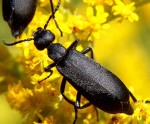 The common name “blister beetle” is given to 7,500 species of beetles in the Meloidae family that secret cantharidin, a chemical that causes blistering of the skin. They have a worldwide distribution with over 300 species in the United States. They are most active in mid to late summer and can be both beneficial and damaging in the garden; the larvae feed on grasshopper eggs but the adults consume many flowers such as black-eyed Susan, Clematis and Amaranthus, as well as vegetables including tomatoes, beets, and okra. In addition, livestock can be poisoned by eating crushed beetles in cured hay. The genus Epicauta is the largest group and contains many species that cause problems for gardeners.
The common name “blister beetle” is given to 7,500 species of beetles in the Meloidae family that secret cantharidin, a chemical that causes blistering of the skin. They have a worldwide distribution with over 300 species in the United States. They are most active in mid to late summer and can be both beneficial and damaging in the garden; the larvae feed on grasshopper eggs but the adults consume many flowers such as black-eyed Susan, Clematis and Amaranthus, as well as vegetables including tomatoes, beets, and okra. In addition, livestock can be poisoned by eating crushed beetles in cured hay. The genus Epicauta is the largest group and contains many species that cause problems for gardeners.
 Description: Blister beetles are soft bodied, long-legged, and sometimes brightly colored in the western states. Their bodies are narrow and half to one inch in length, their heads broad, their front wings soft and flexible, and their antennae equal to one third the length of their body. These beetles have complete metamorphosis and complete their life cycle in 30 days to 3 years, with one year being typical. Evidence for the presence of blister beetles is usually seen in early to mid summer when they leave behind pebbly black trails of excrement.
Description: Blister beetles are soft bodied, long-legged, and sometimes brightly colored in the western states. Their bodies are narrow and half to one inch in length, their heads broad, their front wings soft and flexible, and their antennae equal to one third the length of their body. These beetles have complete metamorphosis and complete their life cycle in 30 days to 3 years, with one year being typical. Evidence for the presence of blister beetles is usually seen in early to mid summer when they leave behind pebbly black trails of excrement.
 Control: The best way to eliminate blister beetles in the garden is to shake the adults off the plants and then crush them on the ground with your foot. Insecticides are not usually needed in the home garden but livestock owners may need to employ them in order to control insect populations in hay.
Control: The best way to eliminate blister beetles in the garden is to shake the adults off the plants and then crush them on the ground with your foot. Insecticides are not usually needed in the home garden but livestock owners may need to employ them in order to control insect populations in hay.